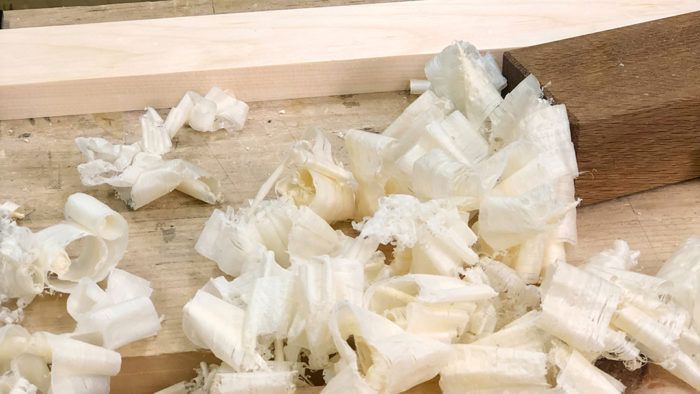Give pine a chance
Pine is normally paired with words like cheap, crummy, and a whole host of terms not used in polite company, but Vic Tesolin doesn't understand why.
Pine.
Eastern white pine.
Pinus strobus.
I often hear disparaging comments about the use of pine in woodworking. Pine is normally paired with words like cheap, crummy, and a whole host of terms I can’t use in polite company, but I don’t understand why. Tons of period pieces, in the vernacular style, were built in my neck of the woods here in Canada. The area was known as Upper Canada and was a part of British Canada from 1791 to 1841. Countless chests, cabinets, and tables were made from pine. Yet now we don’t like it.
Eastern white pine is known for its softness (380 lbf on the Janka Hardness Scale), so it dents easily. However, where one person sees a dent, another sees character and patina. Pine can also be a pain to machine due to its high content of pitch, which gets on everything and sticks to it. That being said, it’s easy to find Eastern white pine at most DIY chains pre-milled and sized to save your machines from the need for a detailed cleaning.
When people are learning to use hand tools, I often recommend that they start with Eastern white pine, and here is why. As I mentioned earlier, pine is soft. Because of this this softness, you need an extremely sharp blade to cut it well. A dull chisel will mash its way through pine but only a keen edge will slice through it, leaving a clean, crisp surface. Having sharp chisels for any woodworking task is critical and the best way to ensure that your sharpening game is up to snuff is to trying paring pine. If you can flawlessly pare pine, you can pare anything and should get clean surfaces.
In the case of a handplane, a dull iron will cut Eastern white pine, but you will only be able to take heavy shavings. The surface left behind by a dull iron will be rough and likely riddled with tearout. But a sharp iron will remove shavings so thin you’ll be able to read through them. More important than fine shavings, the surface you’ll get will be lustrous and smooth, and it will exhibit chatoyance. I have to admit that sanded pine almost always looks like a hot mess, but a hand-planed surface looks incredible.
Eastern white pine is not only an inexpensive and lovely wood to work with hand tools, but it’s also a great choice for furniture and other wooden objects. What do you have to lose? Give pine a chance.
In order to understand, you must do. – V
 |
|
 |
|
 |
Fine Woodworking Recommended Products

AnchorSeal Log and Lumber End-Grain Sealer

DeWalt 735X Planer

Ridgid R4331 Planer























Comments
Underrated for sure! I have recently fallen back in love with Pine after a stint of self righteousness. I think this is part of the common evolution for woodworkers. It starts with being obsessed by figure and detesting paint and stain. Then you realize that tame grain is really great for design. Then if you really get deep, you realize that wood grain can be awfully "loud" and sometimes a splash of color really is warranted. Then you either get into the Shakers or furniture of the Pennsylvania Dutch or even the Shenandoah Valley and BAM! Milk paint isn't just for DIY artificial Patina projects! Sorry, this was supposed to be about Pine. I love pine. Thanks, Vic.
The last pine thing I made was 11 years ago - until the tool cupboard I made last week. Tool cupboards can be utilitarian, I told myself. Why waste my "proper" wood on a tool cupboard when the local purveyor supplies locally-grown pine & spruce ready-planed?
As the article notes, such soft and often knotty stuff is a real test of edge sharpness. The knots also mean swirling grain. Tear out with anything less than a very sharp blade and a thin, thin cut is likely. Even the steep angles of 50 & 60 degrees don't work. Even scraping often fails to cut a nice gossamer shaving! The knots also are only amenable to shaving off in wisper-thin slices. They prefer to bite back at the blade if they can, so perhaps the steel gets planed-off rather than the knot!
The usual planing rules seem turned upside down for pine (and spruce) then. A low cutting angle of 37 - 40 degrees works best, despite the swirling grain. But the edge must be very sharp and the shaving very thin. The soft wood seems to respond best to a very pointy thing not trying to take a thick strip of wood.
It takes ages to smooth and flatten a part, especially if the rings are small-radius (as they often are from Big Store timber) and want to cup everything at the slightest opportunity. Lots of super-thin shavings for lighting the wood stove, mind. Or stuffing the ladywife's teddy bears she makes.
Still, the bluddy tool cupboard is now made and full of things it doesn't deserve.
Lataxe
Log in or create an account to post a comment.
Sign up Log in